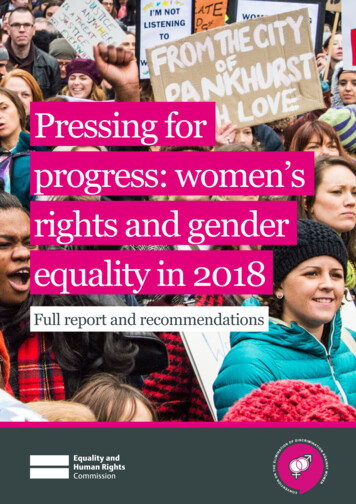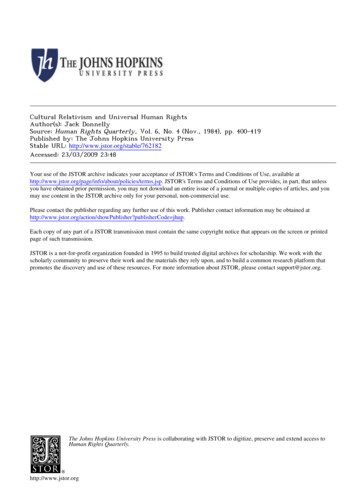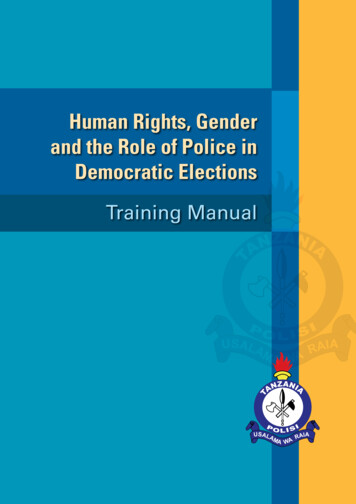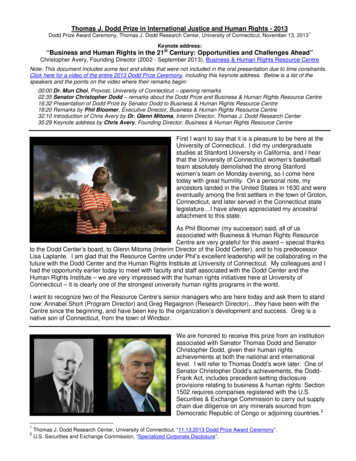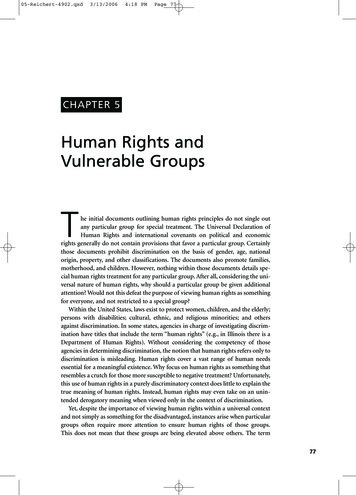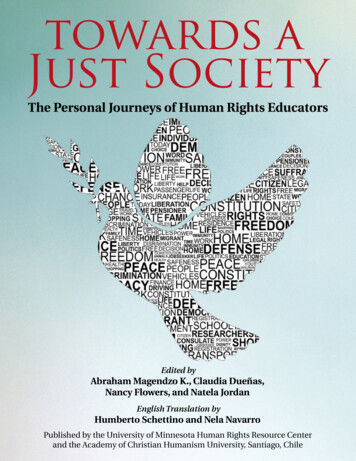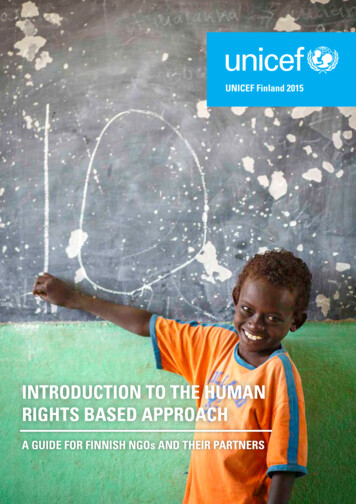
Transcription
UNICEF Finland 2015INTRODUCTION TO THE HUMANRIGHTS BASED APPROACHA GUIDE FOR FINNISH NGOs AND THEIR PARTNERS
Guidelines developed by:Anton Hausen and Annika LaunialaInternational Advocacy and Programmes Finnish Committee for UNICEFwww.unicef.fi/HRBAFunded by:The Ministry for Foreign Affairs of FinlandUnit for Non-Governmental OrganizationsCover photo: UNICEF/ETHA 2014 00243/OseLayout: Elise RehulaPrinted by: T-print LP, 2015ISBN 978-952-9536-18-4ISBN 978-952-9536-19-1 (pdf)Printed using FSC-certified paper.
CONTENTSFOREWORD4ABBREVIATIONS5INTRODUCTION6WHAT IS A HUMAN RIGHTS BASED APPROACH?8THE NATIONAL FRAMEWORK OF THE HRBA IN FINNISH DEVELOPMENT CO-OPERATION13CORE PRINCIPLES OF THE HRBA14THE POOREST, WEAKEST, MOST MARGINALISED AND VULNERABLE17HUMAN RIGHTS BASED PROJECT PLANNING211. SITUATION ANALYSIS222. CAUSALITY ANALYSIS233. ROLE PATTERN ANALYSIS254. CAPACITY GAP ANALYSIS265. IDENTIFICATION OF CANDIDATE STRATEGIES AND ACTIONS276. PARTNERSHIP ANALYSIS287. PROJECT DESIGN28PROJECT IMPLEMENTATION29MONITORING AND EVALUATION30KEY HRBA TERMINOLOGY32REFERENCES34RESOURCES AND USEFUL LINKS35
FOREWORDHuman rights and development cannot be separated and the promotion ofhuman rights and equality is at the center of Finland’s development policy. Byintegrating human rights in development cooperation, we aim at promotinghuman centered development, addressing injustices and discriminatory structures in society and ensuring inclusive processes where those most vulnerable are not forgotten. Human rights provide a universally agreed framework,which benefits the recipients of development assistance and guides the various actors in their work as well.In line with the UN Universal Declaration of Human Rights and the humanrights conventions, Finland’s human rights-based development policy stemsfrom the idea that all human beings are born free and equal in dignity and inrights. The human rights based approach (HRBA) to development includescivil and political rights and freedoms, as well as economic, social and culturalrights. The HRBA is a lens, through which we can identify barriers to development and patterns of discrimination.The guidelines developed by the Finnish Committee for UNICEF, with the support of the Unit for Civil Society of the Foreign Ministry, is a welcome contribution to deepening the knowledge on how to put the HRBA into practice.The guidelines are based on the United Nations Common Understanding onthe HRBA and the experience and know-how of UNICEF. I value the effortsmade by the Finnish Committee for UNICEF in developing practical guidelines, initiating the discussion and bringing the work forward on how makefull use of the HRBA in practice - to the benefit for the people we want tohelp.I therefore hope that the UNICEF Finland guidelines will be inspirational andprovide a road map for Finnish and international non-governmental organizations implementing projects funded by Finland. I strongly encourage furtherdiscussion with government and civil society partners on best practices andon how to meet challenges related to the HRBA in practice. The learning process needs to continue and I look forward to seeing the results of the toolbox developed by UNICEF Finland.Sirpa Paatero,Minister for International DevelopmentINTRODUCTION TO THE HUMAN RIGHTS BASED APPROACH, UNICEF Finland4
ABBREVIATIONSCATConvention Against Torture and other Cruel, Inhuman orDegrading Treatment or PunishmentCDCCenters for Disease Control and PreventionCEDAWConvention on the Elimination of All Forms of DiscriminationAgainst WomenCPARCanadian Physicians for Aid and ReliefCRCConvention on the Rights of the ChildCRPDConvention on the Rights of Persons with DisabilitiesHIV/AIDSHuman Immunodeficiency Virus Infection and Acquired ImmuneDeficiency SyndromeHRBAHuman Rights Based ApproachICCPRInternational Covenant on Civil and Political RightsICERDInternational Convention on the Elimination of All Forms ofRacial DiscriminationICESCRInternational Covenant on Economic, Social and Cultural RightsICRMWConvention on the Rights of all Migrant Workers and their FamiliesILOInternational Labor OrganizationITNInsecticide-Treated NetsLGBTILesbian, Gay, Bisexual and Trans and IntersexM&EMonitoring and EvaluationMFAMinistry for Foreign AffairsMOHPMinistry of Health and PopulationNGONon-Governmental OrganizationOECD/DAC Organization for Economic Cooperation and Development (OECD)Development Assistance Committee (DAC)PSIPopulation Services InternationalRBMResults Based ManagementUDHRUniversal Declaration of Human RightsUNUnited NationsUNICEFUnited Nations Children’s FundUSAIDUnited States Agency for International DevelopmentWHOWorld Health OrganizationINTRODUCTION TO THE HUMAN RIGHTS BASED APPROACH, UNICEF Finland5
6 UNICEF/BANA2013-01238/KironINTRODUCTION TO THE HUMAN RIGHTS BASED APPROACH, UNICEF Finland
INTRODUCTIONThese guidelines aim to address the need for easy-to-understand guidance on what the human rights based approach(HRBA) entails in the different phases of a project cycle, starting from the planning phase up to the monitoring and evaluation of a project. The foundation of these guidelines lie in theUnited Nations common understanding of the HRBA, a modelwidely recognized 1 within the international development community. These guidelines are meant to be practical and therefore concentrate on explaining the core principles and steps ofthe HRBA through practical case examples and illustrations. Amanual providing practical tools on how to carry out a projectplanning processes, utilizing the HRBA with partners, is available separately.These guidelines are primarily intended to benefit both Finnishand international non-governmental organizations (NGOs) thatimplement development cooperation projects with funding fromthe Finnish government. In addition, it is envisioned that the guidelines would serve as a reference document for the NGOs of theSouth - particularly those that partner with Finnish NGOs. At thesame time, the content may prove beneficial to a wider audience.However, it should be recognized that people working in a project management or programming capacity, or with NGOs thatare about to start a new project, fall into the main target audience. The guidelines have been developed with the idea thatboth, an experienced development professional and someone who is just beginning to work with a NGO and planning anew project, can benefit from these guidelines. Nevertheless,if it is assumed that the reader is working on a project funded by the government of Finland, he or she is already familiar with the basics of the project cycle concepts, and with the“Development Cooperation of the Civil Society Organizations:Project Guidelines” developed by the Ministry for ForeignAffairs of Finland.INTRODUCTION TO THE HUMAN RIGHTS BASED APPROACH, UNICEF Finland7
WHAT IS A HUMAN RIGHTSBASED APPROACH?A human rights based approach is focused on conscious and systematic enhancement of humanrights in all aspects of project and program development and implementation. It is a conceptualframework for the process of human development that is normatively based on international human rights standards and operationallydirected to promoting and protecting humanrights. The Universal Declaration of Human Rights(UDHR 1948) and other international human rightsinstruments form the core basis of the HRBAconceptual framework. The human rights basedapproach has a twofold objective:1) to empower people (rights-holders) to claimand exercise their rights and2) to strengthen the capacity of the actors (dutybearers) who have a particular obligation orresponsibility to respect, protect and fulfill therights of the poorest, weakest, most marginalized and vulnerable, and to comply with theseobligations and duties. See Figure 1. HRBAtwo-fold objective.The term rights-holder is used to refer to individuals or social groups that have particular entitlements in relation to specific rights. For example, children are rights-holders and their parentsare considered first-line duty-bearers accordingto the Conventions of the Rights of the Child:hence, parents have obligations and responsibilities to respect, protect and fulfill the rights of thechildren.The term duty-bearer is most commonly used torefer to state actors and official authorities at alllevels. The state is the ultimate duty-bearer as itratifies international conventions. It is importantto understand that the responsibility of the statearises from their ratification process of international conventions. If a state has not ratified a certain document, its legal duty is not binding andcannot be appealed to the same way as to stateswho have ratified the conventions. Non-stateactors can in some instances also be consideredas duty-bearers. Depending on the context andsituation, individuals such as parents, local organizations, private companies, aid donors, international institutions, rebel groups, armed forces andso on can be duty-bearers.RIGHTS-HOLDERSDUTY-BEARERSare individuals or social groups that haveparticular entitlements in relation to specific duty-bearers. In general terms, allhuman beings are rights-holders under theUniversal Declaration of Human Rights. Inparticular contexts, there are often specific social groups whose human rights arenot fully realized, respected, protectedor fulfilled. These groups tend to includewomen/girls, children in general, ethnicminorities, indigenous peoples, adults andchildren with special needs, migrants andyouth.are those actors who have a particularobligation or responsibility to respect,protect, promote and fulfill human rights,and to abstain from human rights violations. Duty-bearers are both state andnon-state actors. However, the ultimateduty-bearer is the state as it ratifies theinternational conventions.INTRODUCTION TO THE HUMAN RIGHTS BASED APPROACH, UNICEF Finland8
The HRBA recognizes that duty-bearers are notalways able to comply with their obligations andduties for several reasons. For example, parents don’t always have adequate knowledge andresources to take their children to the hospital fortreatment and the medical staff may not have themedication and equipment needed for making anappropriate diagnosis and providing treatment;the district health officer has resource limitationsthat affect the quality of provided treatment, andthe government, as ultimate duty-bearer shouldhave made the necessary budgetary allocation tothe health sector to ensure that the child’s right tohealth and wellbeing is fulfilled.Due to these different factors, these duty-bearers are not able to protect and fulfill a child’s rightto health and wellbeing. This makes all actorsinvolved in development cooperation projects,including NGOs, accountable for working withlocal partners to strengthen the capacity of theduty-bearers to become more effective in realizing their duties.Figure 1. HRBA Two-fold ObjectiveThe HRBA is also a tool to reach people who arethe poorest and most vulnerable. It allows theviews of the people (rights-holders) to be takeninto account in such communities through activeengagement and participation, providing comprehensive understanding of the problems at handand their causes and consequences. The HRBAensures that projects aren’t planned in isolationfrom reality and without an understanding of theconcerns of the perspective of rights-holders andduty-bearers. The process through which concrete results are achieved is fundamental in allHRBA-based project planning. The process is asimportant as the results. Therefore, the HRBA is atool for empowerment: one that acknowledges that the situation of people cannot changefor the better without people’s ownership.Over the last decade, human rights have gainedprominence as a universal set of norms and standards that are increasingly shaping the programsand activities, including within the United Nations(See Figure 2. UN’s Statement on CommonUnderstanding of Human Rights Based Approachto Development Cooperation and INTRODUCTION TO THE HUMAN RIGHTS BASED APPROACH, UNICEF Finland9
It is widely recognized that promoting and protecting human rights is crucial for achievingpeace, sustainable human development, democracy and security, and that these aspirations andcommon goals are inseparably linked and interdependent. An approach based on human rightsis more and more regarded as an essential toolfor achieving sustainable development outcomes.The many benefits of the HRBA can be summedup as follows: Promotes realization of human rights and helpsgovernment partners achieve their humanrights commitments; increases and strengthens the participation ofthe local community; improves transparency; promotes results and aligns with resultsbased management, which is used to ensureand measure aid effectiveness; increases accountability; reduces vulnerabilities by focusing on themost marginalized and excluded in society; more likely to lead to sustained change ashuman rights based programs have beendesigned to have impact on cultural and socialnorms and values, structures, policy, andpractice.Figure 2. UN’s Statement on Common Understanding of HumanRights Based Approach to Development Cooperation and ProgramsGOALAll programs of development cooperation,policies and technical assistance shouldfurther the realization of human rights aslaid down in the UN Declaration of HumanRights and other international humanrights instruments.PROCESSHuman rights standards and principlesguide all development cooperation andprogramming in all sectors and phases ofthe programming process.OUTCOMEDevelopment cooperation contributesto the development of the capabilities of’duty-bearers’ to meet their obligationsand/or of ’rights-holders’ to claim theirrights.There are some clear differences between projects that are implemented using the HRBAframework and those that are not. The key differences can be simplified and summarized asfollows (See Box 1: Key Differences BetweenHRBA and Non-HRBA Projects):Box 1. Key Differences Between HRBA and Non-HRBA ProjectsHRBA PROJECTNON-HRBA PROJECTProject target group is identified as active actors andagents of change (rights-holders & duty-bearers)Project target group is often perceived as passive,receiving ‘aid’ (beneficiaries)Participation is crucial to provide a voice in theprocessParticipation is limitedParticipants gain awareness of rights and how todemand their fulfillment, as well as, how to fulfill theobligations and duties towards rights-holdersRights are not discussed openly and directlyFocus is on violated, unfulfilled rightsFocus is on needsProcess is as important as resultsResults are often seen more important than processINTRODUCTION TO THE HUMAN RIGHTS BASED APPROACH, UNICEF Finland10
EXAMPLE OF A HUMAN RIGHTSBASED APPROACH TO HEALTHA human rights based approach to health uses a combination ofsupport and pressure to urge government departments to makebasic health care accessible and affordable for all people in thecountry. It supports people and organizations in demandingbetter health services from the government and from other dutybearers: allocating the health budget in a way that benefits thepoor rather than the rich, making health services more patientfriendly, making health insurance affordable for all people,providing access to safe drinking water, or controlling pollutingindustries. Far from creating dependency, such an approachempowers people to take action to claim their due, rather thanpassively accepting whatever the government is willing to givethem. Adopting a human rights based approach to developmenthas implications for programming:BROAD GOAL: A clear focus on children and their rights.EQUITY AND NON-DISCRIMINATION: A focus on the worstrights violations and on the most marginalized children.ACCOUNTABILITY: Strengthening the accountability of dutybearers for children’s rights at all levels. This should be achievedthrough a combination of direct action for children’s rights,changes in laws and policies, institutional practices and adult’sattitudes and behaviors.PARTICIPATION: Empowering rights-holders (children, adultsand civil society institutions) to demand child rights. Thepromotion of children’s participation in society and in programs.BEST INTERESTS OF THE CHILD: Programming based on whatis in children’s best interests in the short and long term.LINKAGES: Working with other government and nongovernment agencies towards common rights-based goals. 2INTRODUCTION TO THE HUMAN RIGHTS BASED APPROACH, UNICEF Finland11
Elise RehulaINTRODUCTION TO THE HUMAN RIGHTS BASED APPROACH, UNICEF Finland12
THE NATIONAL FRAMEWORK OF THEHRBA IN FINNISH DEVELOPMENTCOOPERATIONThe roots of the HRBA for Finnish development liein Finland s international commitments to advancehuman rights, such as the core UN human rightstreaties (See Box 2: Core Human Rights Treaties).Finland has ratified numerous additional international conventions with a bearing on humanrights, including ILO Conventions. The HRBA inFinnish development cooperation guides development cooperation performed bilaterally, as projector program-based cooperation through local cooperation funds and Finnish NGOs, and multilaterally, through global, financial and regional partnerships and through institutional cooperation. HRBAin Finnish development cooperation is explicitlyreferred to in the following documents: Manual for Bilateral Programmes Development Cooperation Manual for NGOs Finland s Development Policy Programme2012 Implementing the Human Rights BasedApproach In Finland’s Development PolicyGuidelines Cross-cutting Objectives of DevelopmentCooperation – Guidelines HEL7215-63 3 Human Rights Strategy of the ForeignService of Finland Human Rights Action Plan of the ForeignService of Finland 2013-2015 4The integration of the HRBA into the Finnish national foreign policy and development cooperationagendas can be summarized in five points.First of all, Finnish development cooperation isbased on human rights.Secondly, it does so by supporting duty-bearersin fulfilling their obligations and rights-holders inclaiming their rights, especially with regards topeople who are among the most marginalized andvulnerable.Thirdly, the HRBA is used to contribute to therealization of the cross-cutting objectives of development programs and projects. Systemic application of HRBA ensures that the cross-cutting objectives are addressed at all levels and in all phasesof development cooperation and its managementcycle.Fourthly, the HRBA includes civil, political, economic, social and cultural rights, and freedoms.Fifthly, Finland proactively promotes the HRBA inits foreign and security policy, especially advocating it in the post-2015 process.Box 2: Core Human Rights TreatiesCORE HUMANRIGHTS TREATIES United Nations Charter Universal Declaration of Human Rights International Covenant on Civil and PoliticalRights (ICCPR) and its Optional Protocols International Covenant on Economic,Social and Cultural Rights (ICESCR) and itsOptional Protocol International Convention on the Eliminationof All Forms of Racial Discrimination (ICERD) Convention on the Elimination of All Formsof Discrimination Against Women (CEDAW)and its Optional Protocol Convention Against Torture and OtherCruel, Inhuman or Degrading Treatment orPunishment (CAT) and its Optional Protocol Convention on the Rights of the Child (CRC)and its Optional Protocols Convention on the Rights of All MigrantWorkers and their Families (ICRMW) and Convention on the Rights of Persons withDisabilities (CRPD) and its Optional Protocol.INTRODUCTION TO THE HUMAN RIGHTS BASED APPROACH, UNICEF Finland13
CORE PRINCIPLES OF THE HRBAThe principles of the HRBA should be appliedfrom the onset of project identification and formulation. First of all, all people everywhere in theworld are entitled to human rights. All individualsare equal as human beings by virtue of the inherent dignity of each human person. Secondly, allhuman beings are entitled to their human rightswithout discrimination of any kind, such as race,color, sex, ethnicity, age, language, religion, political or other opinion, national or social origin, disability, property, birth, or other status. Thirdly,every person and all peoples are entitled to active,free and meaningful participation in, contributionto, and enjoyment of civil, economic, social, cultural and political development in which humanrights and fundamental freedoms can be realized.Therefore, it is important to consider: How rights-holders and concerned actors(duty-bearers) can participate in project identification, in particular at the situation analysisstage (See pg. 22). Their participation ensurestheir voice is heard, they participate in gathering data for the situational analysis, are askedto contribute to sources of information, andparticipate in the analysis itself. How people affected by the problem take partin decision making during both the planningprocess and the project implementation. How it is defined who are affected by theproblem, who are the vulnerable, and who arethe marginalized.In order for a project to be human-rights based, itis essential that the planning process, includingsituational analysis in the beginning of the planning process, is conducted following the humanrights principles. In other words, human rightsprinciples guide all programming in all phasesof the programming process including assessment and analysis, planning and design (including setting of goals, objectives and strategies);implementation, monitoring and evaluation. (SeeFigure 3. Guiding Human Rights Principles in AllProgramming Phases).INTRODUCTION TO THE HUMAN RIGHTS BASED APPROACH, UNICEF Finland14
Figure 3. Guiding Human Rights Principles in All Programming PhasesUNIVERSALITY AND INALIENABILITY1Human rights are universal and inalienable. All people everywhere inthe world are entitled to them. The human person, in whom they inherecannot voluntarily give them up. Nor can others take them away fromhim or her. As stated in Article 1 of the UDHR, “All human beings areborn free and equal in dignity and rights”.INDIVISIBILITYHuman rights are indivisible. Whether of a civil, cultural, economic,political or social nature, they are all inherent to the dignity of everyhuman person. Consequently, they all have equal status as rights, andcannot be ranked, a priori, in a hierarchical order.2INTER-DEPENDENCE AND INTER-RELATEDNESS3HUMANRIGHTSPRINCIPLESThe realization of one right often depends, wholly or in part, uponthe realization of others. For instance, realization of the right tohealth may depend, in certain circumstances, on realization of theright to education or of the right to information.EQUALITY AND NON-DISCRIMINATION45All individuals are equal as human beings and by virtue of theinherent dignity of each human person. All human beings areentitled to their human rights without discrimination of any kind,such as race, color, sex, ethnicity, age, language, religion, politicalor other opinion, national or social origin, disability, property, birthor other status as explained by the human rights treaty bodies.PARTICIPATION AND INCLUSIONEvery person and all peoples are entitled to active, free and meaningfulparticipation in, contribution to, and enjoyment of civil, economic, social,cultural and political development, through which human rights andfundamental freedoms can be realized.ACCOUNTABILITY AND RULE OF LAW6States and other duty-bearers are answerable for the observance ofhuman rights. In this regard, they must comply with the legal norms andstandards enshrined in human rights instruments. Where they fail todo so, aggrieved rights-holders are entitled to institute proceedings forappropriate redress before a competent court or other adjudicator, inaccordance with the rules and procedures provided by law.INTRODUCTION TO THE HUMAN RIGHTS BASED APPROACH, UNICEF Finland15
Elise RehulaINTRODUCTION TO THE HUMAN RIGHTS BASED APPROACH, UNICEF Finland16
THE POOREST, WEAKEST, MOSTMARGINALISED AND VULNERABLEIt is important to recognize that the voices, views,opinions, and experiences of the most marginalized are often undermined by the strongest. Inreality, not all people have an equal opportunityto participate: especially those who are vulnerable, disadvantaged and marginalized due to attributes such as age, gender, class, ethnicity, religion, economic situation, sexual orientation andso on. The government of Finland pays particular attention to the rights and equal opportunities of people in such situations. The followingpeople have been highlighted for particular focus.CHILDRENThe fact that children (persons below the ageof 18) are dependent on adults for survival, areusually physically weaker and can be influencedor manipulated by adults, who have the powerto make decisions in society, often gives thema lower status in most societies. In almost allcountries of the world, children are denied political power as they cannot vote and are left out ofdecision making. In most countries, parents arepermitted to punish their children physically, forexample, by hitting them. Psychological punishment and cruelty are noticed in only in extremecases as there are no outward signs and it is notmentioned by the victims. Children’s lower statusin society also means they are more vulnerableto sexual abuse and other forms of violence andexploitation (e.g. child labor) which is detrimental to children s education and both physical andmental wellbeing and development.According to the Convention on the Rights of theChild, states are legally responsible for ensuringallocation of adequate resources for their citizensthrough provision of basic social services in healthand education to enable parents to fulfill theirresponsibilities to the child. According to UNICEF,the concept of child poverty is based on access toa number of specific economic and social rights.These rights include freedom from material andsocial deprivation, premature death, hunger, malnutrition, and lack of access to clean water, sanitation, education, health care and information. 5WOMEN (gender equality)Women’s situation in the world has not changedsignificantly during the past two decades. Theoften quoted UN statistic still holds true: “Womenwork 2/3 of the world’s working hours but earn10% of the world’s income and own less than 1%of its property”. There is ample evidence of thediscrimination and violation of women’s rights allover the world. Particularly women who are poor,GENDERrefers to the social attributes and opportunities associated with being male andfemale. These attributes, opportunitiesand relationships are socially constructed and are learned through socializationprocesses. They are context/ time-specific and changeable. Gender determineswhat is expected, allowed and valued ina woman or a man in a given context. Inmost societies there are differences andinequalities between women and menin rights and responsibilities assigned,activities undertaken, access and control over resources, as well as decisionmaking opportunities. Gender is part of thebroader socio-cultural context.UNWOMENINTRODUCTION TO THE HUMAN RIGHTS BASED APPROACH, UNICEF Finland17
illiterate, disabled, and those who live in ruralareas, have several children, have no cash work,etc., are often invisible in the society and, therefore, are easily ignored by civil servants, decision makers and even program planners. In SubSaharan Africa alone, the majority of the femalepopulation fall into this category of invisible members of society. It is a known fact that women donot have the same access to education, capital,and resources as men. Yet, women play a key rolein the wellbeing of the household and childrenand, consequently, they need to be recognizedas equal and active members in a society and beempowered to demand their rights.According to the MFA of Finland: “Gender equality is a human rights issue and thus essential fordevelopment and poverty reduction. Measuresthat strengthen gender equality and the status ofwomen promote well-being and economic development and lay the foundation for sustainabledevelopment.” 6PERSONS WITH DISABILITIESPersons with disabilities often experience discrimination in their everyday life. Discriminationdescribes a situation where an individual is disadvantaged in some way because of a ‘protectedcharacteristic’. Discrimination takes place in different forms. It can be direct or indirect, manifestin the form of harassment, or there can be directinstruction to discriminate.7 Direct discriminationis based on negative attitudes, prejudice, and/oron discriminatory legislation. Indirect discrimination, for example, can be caused by physical barriers, such as stairs as the only means to get to vitallocations, or by the use of media. For example,people who are visually impaired or have difficulties hearing cannot use media without assistance.Indirect discrimination is banned by internationallegal instrument and Finnish legislation.A general argument is that you seldom see children with disabilities in schools in Finnish development partner countries. The explanation is notthat poor parents do not have children with disabilities. Quite the contrary, disability is morecommon in poor populations, but children withdisabilities cannot get to school for a variety ofreasons. Obstacles to inclusion of children ofdisabilities include negative attitudes, prejudice,unsuitable transport, physical and legal barriers,study material and, generally, the lack of necessary support services.8 It should be noted thatindirect discrimination can also be based on prejudice and attitudes, but the difference is often thatdirect discrimination is based on intent to differentiate whereas indirect discrimination is a result ofnot considering the differentiate
framework for the process of human develop-ment that is normatively based on internation-al human rights standards and operationally directed to promoting and protecting human rights. The Universal Declaration of Human Rights (UDHR 1948) and other international human rights instruments form the core basis of the HRBA conceptual framework.




